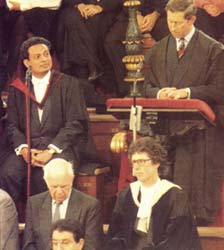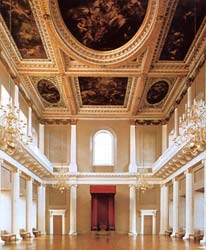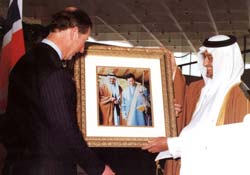PAINTING & PATRONAGE
by John Sheeran
‘That which binds our two worlds together is so much more powerful than that which divides us.’ HRH The Prince of Wales, Islam and the West 1993
In October 1993, HRH The Prince of Wales gave a lecture entitled Islam and the West at the Sheldonian Theatre, Oxford, in his capacity as Patron of the Oxford Centre for Islamic Studies. In it, he put forward a strong argument and made a heartfelt plea for a more serious and balanced reassessment of Islam: ‘The degree of misunderstanding between the Islamic and Western worlds remains dangerously high … the need for the two to live and work together in our increasingly independent  world has never been greater.’ The Prince referred to the suspicion, mistrust, and fear that has existed for centuries between the West and Islam but also spoke of the many shared values between them, such as a common monotheistic vision, respect for knowledge, justice, compassion towards the poor and underprivileged, the importance of family life, and respect for parents. He highlighted the dangers posed by extremism and superficial knowledge and stressed the need for the West to understand how it is perceived by the Islamic world: ‘There is nothing to be gained, and much harm to be done, by refusing to comprehend the extent to which people in the Islamic world genuinely fear our own Western materialism and mass culture as a deadly culture and way of life’. There is a great deal, he argued, which the West can learn from the philosophy and values of Islam, especially from its integral view of the Universe: ‘Islam refuses to separate man and nature, religion and science, mind and matter, and has preserved a metaphysical and unified view of ourselves and the world around us’. He spoke of a deep and fundamental need for the West itself to rediscover the balance between the spiritual and the material dimension. The Prince argued that tolerance, respect, and understanding for each other’s culture, and exchange between them, was crucial in helping to break down prejudice and advance a healthy and mutually beneficial cross-fertilisation of ideas and knowledge.
world has never been greater.’ The Prince referred to the suspicion, mistrust, and fear that has existed for centuries between the West and Islam but also spoke of the many shared values between them, such as a common monotheistic vision, respect for knowledge, justice, compassion towards the poor and underprivileged, the importance of family life, and respect for parents. He highlighted the dangers posed by extremism and superficial knowledge and stressed the need for the West to understand how it is perceived by the Islamic world: ‘There is nothing to be gained, and much harm to be done, by refusing to comprehend the extent to which people in the Islamic world genuinely fear our own Western materialism and mass culture as a deadly culture and way of life’. There is a great deal, he argued, which the West can learn from the philosophy and values of Islam, especially from its integral view of the Universe: ‘Islam refuses to separate man and nature, religion and science, mind and matter, and has preserved a metaphysical and unified view of ourselves and the world around us’. He spoke of a deep and fundamental need for the West itself to rediscover the balance between the spiritual and the material dimension. The Prince argued that tolerance, respect, and understanding for each other’s culture, and exchange between them, was crucial in helping to break down prejudice and advance a healthy and mutually beneficial cross-fertilisation of ideas and knowledge.
 The symbolism of giving such an address at the Sheldonian Theatre, one of the masterpieces of Sir Christopher Wren and an architectural jewel of Western civilisation, was not lost on the Prince. Nor was its significance forgotten by HRH Prince Khalid Al-Faisal bin Abdul Aziz Al-Saud, who himself had studied at Oxford and knew the building well, when he began seven years later to plan a joint exhibition, Painting & Patronage, by himself and the Prince of Wales. Prince Khalid Al-Faisal’s idea was to show the exhibition both in the United Kingdom and the Kingdom of Saudi Arabia, as a celebration of a common cultural bond not only between the two Princes, but also between their two countries and their two cultures.
The symbolism of giving such an address at the Sheldonian Theatre, one of the masterpieces of Sir Christopher Wren and an architectural jewel of Western civilisation, was not lost on the Prince. Nor was its significance forgotten by HRH Prince Khalid Al-Faisal bin Abdul Aziz Al-Saud, who himself had studied at Oxford and knew the building well, when he began seven years later to plan a joint exhibition, Painting & Patronage, by himself and the Prince of Wales. Prince Khalid Al-Faisal’s idea was to show the exhibition both in the United Kingdom and the Kingdom of Saudi Arabia, as a celebration of a common cultural bond not only between the two Princes, but also between their two countries and their two cultures.
In early 2000, Prince Khalid Al-Faisal was looking for a suitable venue in London to exhibit a group of paintings, many of Asir Province, in the south-western part of the Kingdom of Saudi Arabia, where he is Governor. The pictures had been painted by the Prince of Wales, the British royal tour artist, James Hart Dyke, and himself. Prince Khalid Al-Faisal chose the Banqueting House in Whitehall and indicated that the exhibition design of Charles Marsden-Smedley should, if possible, visually fuse the cultural traditions of Islam and the West. The Banqueting House, commissioned by King James I and designed by Inigo Jones, with a magnificent ceiling by Rubens commissioned by King Charles I to celebrate the achievements of his father’s reign, epitomises past royal taste and patronage. One of the first Classical buildings in England since Roman times, it featured as the focus for royal and court ceremonies and entertainment at Whitehall Palace, of which it is the only surviving part. Many national and international events in British history have taken place at the Banqueting House, including the execution of Charles I and the Restoration to the throne of Charles II. The centrepiece of Marsden-Smedley’s powerful design is a large Arab tent, which occupies centre stage amidst the Classical and Baroque splendour surrounding it. This visual statement is an intentionally dramatic one, which gives the spectator and immediate impression of a marriage of cultures, and is symbolic of the acknowledgement and understanding, which the Prince of Wales advocated in his Oxford lecture.
 HRH Prince Khalid Al-Faisal and HRH The Prince of Wales have known each other for many years and have considerable respect for each other. They have much in common, especially in the wide range of their cultural interests and patronage of the arts. Both champion the arts as the heart of a balanced and flourishing society, and, as practising non-professional artists and writers, seek to express their personal thoughts and feelings about the world in which they live with honesty and integrity.
HRH Prince Khalid Al-Faisal and HRH The Prince of Wales have known each other for many years and have considerable respect for each other. They have much in common, especially in the wide range of their cultural interests and patronage of the arts. Both champion the arts as the heart of a balanced and flourishing society, and, as practising non-professional artists and writers, seek to express their personal thoughts and feelings about the world in which they live with honesty and integrity.
Funds raised from the London exhibition went towards a Summer Programme for young artists at The Prince’s Foundation in London’s Shoreditch. In its inaugural year, this included workshops for students of the King Fahad Academy and other London-based schools. The London exhibition was open to the public free of charge from 16-21 June 2000. It was accompanied by a 136-page fully illustrated colour exhibition catalogue, which includes forewords by both Princes, still available in hardback at £50.00 and softback at £30.00.
